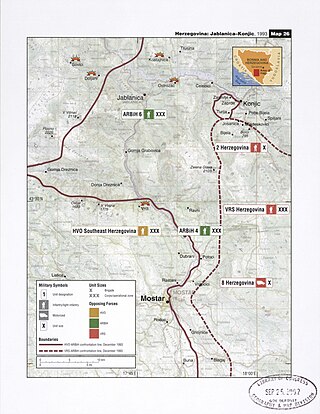
Naser Orić is a former Bosnian military officer who commanded Army of the Republic of Bosnia and Herzegovina (ARBiH) forces in the Srebrenica enclave in eastern Bosnia surrounded by Bosnian Serb forces, during the Bosnian War.

The Bosnian War was an international armed conflict that took place in Bosnia and Herzegovina between 1992 and 1995. The war is commonly seen as having started on 6 April 1992, following a number of earlier violent incidents. The war ended on 14 December 1995 when the Dayton accords were signed. The main belligerents were the forces of the Republic of Bosnia and Herzegovina, the Republic of Herzeg-Bosnia, and the Republika Srpska, the latter two entities being proto-states led and supplied by Croatia and Serbia, respectively.

The Srebrenica massacre, also known as the Srebrenica genocide, was the July 1995 genocidal killing of more than 8,000 Bosniak Muslim men and boys in and around the town of Srebrenica, during the Bosnian War. The killings were perpetrated by units of the Bosnian Serb Army of Republika Srpska (VRS) under the command of Ratko Mladić. The Scorpions, a paramilitary unit from Serbia, who had been part of the Serbian Interior Ministry until 1991, also participated in the massacre.
Sefer Halilović is a Bosnian former general and commanding officer of the Bosnian Army during the 1992–95 war in Bosnia and Herzegovina. In 2001, he was indicted for war crimes by the International Criminal Tribunal for the former Yugoslavia and acquitted of all charges in 2005.

The Army of the Republic of Bosnia and Herzegovina, often referred to as Bosnian Army or Bosniak Army, was the military force of the Republic of Bosnia and Herzegovina. It was established by the government of the Republic of Bosnia and Herzegovina in 1992 following the outbreak of the Bosnian War.
The Bosnian War attracted large numbers of foreign fighters and mercenaries from various countries. Volunteers came to fight for a variety of reasons including religious or ethnic loyalties, but mostly for money. Generally, Bosniaks received support from Muslim countries, Serbs from Eastern Orthodox countries, and Croats from Catholic countries. The numbers, activities and significance of the foreign fighters were often misrepresented. However, none of these groups constituted more than five percent of any of the respective armies' total manpower strength.

The Ahmići massacre was the mass murder of approximately 120 Bosniak civilians by members of the Croatian Defence Council in April 1993, during the Croat–Bosniak War. The massacre was the culmination of the Lašva Valley ethnic cleansing committed by the political and military leadership of the Croatian Community of Herzeg-Bosnia. It was the largest massacre committed during the conflict between Bosnian Croats and the Bosniak-dominated Bosnian government.

Operation Neretva '93 was an Army of the Republic of Bosnia and Herzegovina (ARBiH) operation against the Croatian Defence Council (HVO) in September 1993 on a 200 km long front from Gornji Vakuf to south of Mostar, one of its largest of the year, during the Croat–Bosniak War. The ARBiH made limited gains in the area of northern Herzegovina and around Mostar, but did not achieve a breakthrough to the southern Neretva, where the HVO retained control. The operation was halted in October. During the operation, dozens of Croat civilians were killed in the Grabovica and Uzdol massacres.

The Croat–Bosniak War was a conflict between the Republic of Bosnia and Herzegovina and the Republic of Herzeg-Bosnia, supported by Croatia, that lasted from 18 October 1992 to 23 February 1994. It is often referred to as a "war within a war" because it was part of the larger Bosnian War. In the beginning, the Army of the Republic of Bosnia and Herzegovina and the Croatian Defence Council (HVO) fought together in an alliance against the Yugoslav People's Army (JNA) and the Army of Republika Srpska (VRS). By the end of 1992, however, tensions between Bosniaks and Bosnian Croats increased. The first armed incidents between them occurred in October 1992 in central Bosnia. The military alliance continued until early 1993, when it mostly fell apart and the two former allies engaged in open conflict.

Rasim Delić was the chief of staff of the Bosnian Army. He was a career officer in the Yugoslav Army but left it during the breakup of Yugoslavia and was convicted of war crimes by the International Criminal Tribunal for the former Yugoslavia for failing to prevent and punish crimes committed by the El Mujahid unit under his command. He was sentenced to 3 years in prison.
Bosnian mujahideen, also called El Mudžahid, were foreign Muslim volunteers who fought on the Bosnian Muslim side during the 1992–95 Bosnian War. They first arrived in central Bosnia in the second half of 1992 with the aim of helping their Bosnian Muslim co-religionists in fights against Serb and Croat forces. Initially they mainly came from Arab countries, later from other Muslim-majority countries. Estimates of their numbers vary from 500 to 6,000.

The Croat–Bosniak War was a conflict between the Republic of Bosnia and Herzegovina and the Croatian Community of Herzeg-Bosnia, supported by Croatia, that lasted from 19 June 1992 – 23 February 1994. The Croat-Bosniak War is often referred to as a "war within a war" because it was part of the larger Bosnian War.

The siege of Mostar was fought during the Bosnian War first in 1992 and then again later in 1993 to 1994. Initially lasting between April 1992 and June 1992, it involved the Croatian Defence Council (HVO) and the Army of the Republic of Bosnia and Herzegovina (ARBiH) fighting against the Serb-dominated Yugoslav People's Army (JNA) after Bosnia and Herzegovina declared its independence from Yugoslavia. That phase ended in June 1992 after the success of Operation Jackal, launched by the Croatian Army (HV) and HVO. As a result of the first siege around 90,000 residents of Mostar fled and numerous religious buildings, cultural institutions, and bridges were damaged or destroyed.
Amir Kubura is a former Bosnian commander of the Army of the Republic of Bosnia and Herzegovina and officer of the Yugoslav People's Army who was indicted by the International Criminal Tribunal for the former Yugoslavia and sentenced to two years imprisonment for 'plunder of public or private property'.
The Vranica massacre was the killing of 13 Army of the Republic of Bosnia and Herzegovina (ARBiH) prisoners of war (POWs) on 10 May 1993 by the Croatian Defence Council (HVO), during the Bosnian War.
The Battle of Bugojno was fought between forces of the Army of the Republic of Bosnia and Herzegovina (ARBiH) and the Croatian Defence Council (HVO) for control of the town and municipality of Bugojno in central Bosnia, from 18–28 July 1993. The area of Bugojno was under joint control of the ARBiH 307th Brigade and the HVO Eugen Kvaternik Brigade since the start of the Bosnian War. Violent incidents in Bugojno followed the escalation of the Croat-Bosniak War in adjacent municipalities throughout the 1st half of 1993. Bugojno was spared from fighting and the two local brigades were still formally allied by June 1993, at the time of an ARBiH offensive in central Bosnia.
The Uzdol massacre refers to the murders of at least 25 ethnic Croat inhabitants of the village of Uzdol by members of the Army of the Republic of Bosnia and Herzegovina (ARBiH) on 14 September 1993, during Operation Neretva '93, part of the Croat-Bosniak War.
The Battle of Travnik was a battle between the Croatian Defence Council (HVO) and the Army of the Republic of Bosnia and Herzegovina (ARBiH) to stop Bosniak aggression in the areas of Travnik and the Travnik region inhabited by Croats.










